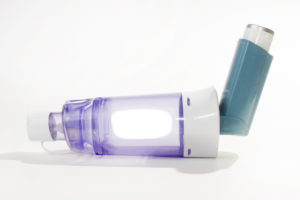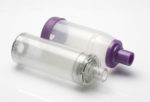 Asthma Spacers are large, plastic containers that fit onto an inhaler. They have a mouthpiece at one end and a hole at the other end of the inhaler to be placed in. They only work with aerosol inhalers and they are designed to give a metered dose of medication. The spacer makes it easier to inhale the medication into the lungs, allowing the child to get the correct dose in the correct way.
Asthma Spacers are large, plastic containers that fit onto an inhaler. They have a mouthpiece at one end and a hole at the other end of the inhaler to be placed in. They only work with aerosol inhalers and they are designed to give a metered dose of medication. The spacer makes it easier to inhale the medication into the lungs, allowing the child to get the correct dose in the correct way.
There are different types of asthma spacer and some have face masks so they can be used with infants. The actual training in using a spacer is normally given by a doctor or medical professional but this page covers the basics.
Benefits of Using Spacers
The medication is delivered into the spacer and collects there. It is then inhaled, avoiding the need to get the timing and speed exactly right. Spacers prevent the medication ending up in the mouth or back of the throat rather than in the lungs. Using an Asthma Spacer makes the drug more efficient because it is taken in more slowly. Therefore it gets deeper into the lungs causing more of an effect.
Side effects are also reduced as they can reduce the amount of drug that is absorbed into other parts of the body.
Easy Instructions to Use an Asthma Spacer
- Take off the cap and shake the inhaler.
- Fit the inhaler into the end of your spacer.
- Breathe out gently as long as feels comfortable.
- Put the mouthpiece between your teeth and lips, making a seal so no medicine can escape.
- Press the canister once to insert your medicine into the spacer.
- Breathe in slowly and steadily (not hard and fast) through the mouthpiece.
- Remove the spacer from your mouth and hold your breath for 10 seconds (or for as long as is comfortable) then breathe out slowly.
- If you need a second dose, wait 30 seconds, remove the inhaler, shake it and repeat the steps above. Repeat the steps for each dose needed.
It is essential that you keep the spacer in your mouth with your lips sealed around it and breathe in and out of the mouthpiece five times. Research has shown breathing in and out in this way, using your spacer, is just as effective as holding your breath for 10 seconds as above.
Helping a Child
When using with children it is important to explain to them exactly what they have to do and why it is important. This puts them at ease and will make it easier for you to administer the medication. Then what you do is to:
- Remove the cap and shake the inhaler, your child can help with this;
- Put the inhaler into the end of the spacer;
- Place the mouthpiece between your child’s teeth and lips, making a seal so no medicine can escape;
- Press the canister once to put one puff of your child’s inhaler medicine into the spacer;
- Get them to breathe in and out of the mouthpiece five times;
- Repeat from step 2 for each puff of the inhaler needed, remembering to take out the inhaler and shake it before each puff.
After use, it is important to clean the spacer correctly with detergent carefully not scrubbing and damaging it. Leave it to air dry and although they sometimes look cloudy over time, they will last many months. If you have any questions, ask your medical professional.
For more videos like the one above, take a look at firstaidshow.com
For more information on training courses, visit our “Courses” page which also includes our First Responder and First Person on Scene (FPOS) Courses.

